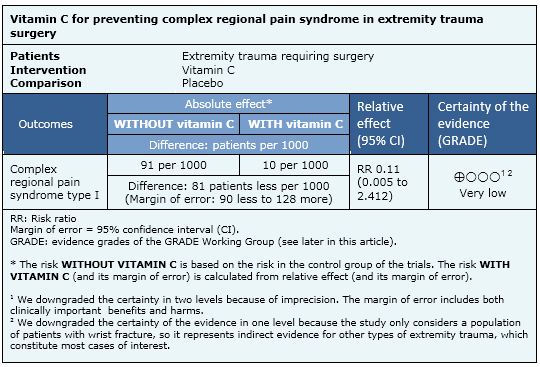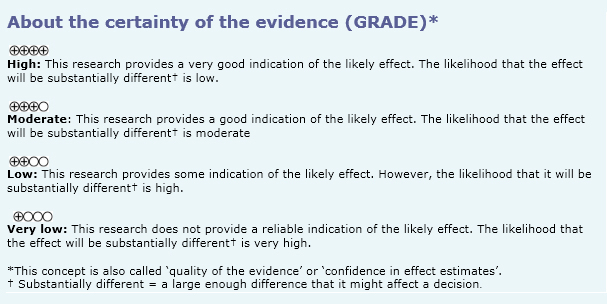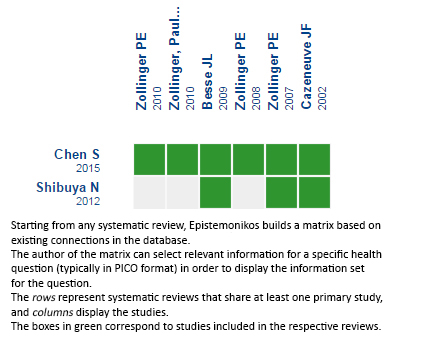Abstract
The complex regional pain syndrome is a neuroinflammatory pathology that affects the central and peripheral nervous system, characterized by disproportional pain in relation to the trauma experimented by the patient. It has been proposed that vitamin C could prevent the development of this syndrome in patients with limb trauma and surgery. Searching in Epistemonikos database, which is maintained by screening 30 databases, we identified two systematic reviews that indentified four primary studies, including one randomized controlled trial. We generated a summary of findings table following the GRADE approach. We concluded it is uncertain whether vitamin C prevents complex regional pain syndrome because the certainty of the evidence is very low.
Problem
Complex regional pain syndrome is a condition that may occur following a traumatism or extremity surgery. It contributes to a longer hospital stay and a slower rehabilitation process. Vitamin C is a safe and low cost medication, whose antioxidant properties might stabilize free radicals that normally damage the lipid membranes and the microcirculation, therefore it has been proposed it could prevent the onset of the complex regional pain syndrome in patients with extremity trauma, especially those that require surgery.
Methods
We used Epistemonikos database, which is maintained by screening more than 30 databases, to identify systematic reviews and their included primary studies. With this information we generated a structured summary using a pre-established format, which includes key messages, a summary of the body of evidence (presented as an evidence matrix in Epistemonikos), meta-analysis of the total of studies in case more than one pertinent study is identified, a summary of findings table following the GRADE approach and a table of other considerations for decision-making.
|
Key messages
|
About the body of evidence for this question
|
What is the evidence. |
We found two systematic reviews [1],[2] including four primary studies reported in six references [3],[4],[5],[6],[7],[8], of which only one correspond to a randomized controlled trial (reported in two references) [6],[7]. This table and the summary in general are based on the latter. |
|
What types of patients were included |
Adults (18 years or more), with a fracture of one or both wrists, under conservative treatment or surgery. All types of wrist fractures were included. The included surgical treatments were closed reduction external fixation (bridging technique), closed reduction and internal fixation (Kapandji) and open reduction and internal fixation. |
|
What types of interventions were included |
The study compared daily doses of 200, 500 and 1500 mg for 50 days starting the day of the injury. The comparison was against placebo. |
|
What types of outcomes were measured |
Incidence of complex regional pain syndrome clinically diagnosed using Veldman criteria, having to fulfill 4 of the 5 following criteria:
|
Summary of findings
The information on the effects of vitamin C for the prevention of complex regional pain syndrome type I is based on one randomised controlled trial including 416 patients with 427 wrist fracture, of which 48 required surgical treatment (only the latter were considered in our analysis).
- It is uncertain whether vitamin C prevents complex regional pain syndrome in patients with extremity trauma that require surgery because the certainty of the evidence is very low.


Other considerations for decision-making
|
To whom this evidence does and does not apply |
|
| About the outcomes included in this summary |
|
| Balance between benefits and risks, and certainty of the evidence |
|
| Resource considerations |
|
|
Differences between this summary and other sources |
|
| Could this evidence change in the future? |
|
How we conducted this summary
Using automated and collaborative means, we compiled all the relevant evidence for the question of interest and we present it as a matrix of evidence.
Matrix of evidence (static version).
Follow the link to access the interactive version Efficacy of vitamin C for complex regional pain syndrome in extremity surgery
Notes
The upper portion of the matrix of evidence will display a warning of “new evidence” if new systematic reviews are published after the publication of this summary. Even though the project considers the periodical update of these summaries, users are invited to comment in Medwave or to contact the authors through email if they find new evidence and the summary should be updated earlier. After creating an account in Epistemonikos, users will be able to save the matrixes and to receive automated notifications any time new evidence potentially relevant for the question appears.
The details about the methods used to produce these summaries are described here http://dx.doi.org/10.5867/medwave.2014.06.5997.
Epistemonikos foundation is a non-for-profit organization aiming to bring information closer to health decision-makers with technology. Its main development is Epistemonikos database (www.epistemonikos.org).
These summaries follow a rigorous process of internal peer review.
Conflicts of interest
The authors do not have relevant interests to declare.

 Matrix of evidence (static version).
Matrix of evidence (static version).
 Esta obra de Medwave está bajo una licencia Creative Commons Atribución-NoComercial 3.0 Unported. Esta licencia permite el uso, distribución y reproducción del artículo en cualquier medio, siempre y cuando se otorgue el crédito correspondiente al autor del artículo y al medio en que se publica, en este caso, Medwave.
Esta obra de Medwave está bajo una licencia Creative Commons Atribución-NoComercial 3.0 Unported. Esta licencia permite el uso, distribución y reproducción del artículo en cualquier medio, siempre y cuando se otorgue el crédito correspondiente al autor del artículo y al medio en que se publica, en este caso, Medwave.

El síndrome de dolor regional complejo es una patología neuroinflamatoria que afecta tanto al sistema nervioso central como al periférico, y se caracteriza por dolor desproporcionado en relación al trauma experimentado por el paciente. Se ha planteado que el uso de vitamina C podría prevenir la aparición de este síndrome en pacientes con trauma y cirugía de extremidades. Utilizando la base de datos Epistemonikos, la cual es mantenida mediante búsquedas en 30 bases de datos, identificamos dos revisiones sistemáticas que en conjunto incluyen sólo un estudio controlado aleatorizado. Realizamos una tabla de resumen de los resultados utilizando el método GRADE. Concluimos que existe incertidumbre sobre si la vitamina C podría ser útil en la prevención del síndrome de dolor regional complejo en estos pacientes porque la certeza de la evidencia es muy baja.
 Authors:
Jorge Cabrolier[1,3], Marcelo Molina[2,3]
Authors:
Jorge Cabrolier[1,3], Marcelo Molina[2,3]
Affiliation:
[1] Pontificia Universidad Católica de Chile, Santiago, Chile
[2] Departamento de Traumatología y Ortopedia, Facultad de Medicina, Pontificia Universidad Católica de Chile, Santiago, Chile
[3] Proyecto Epistemonikos
E-mail: mmolinas@med.pu.cl
Author address:
[1] Facultad de Medicina
Pontificia Universidad Católica de Chile
Lira 63,
Santiago Centro
Chile

Citation: Cabrolier J, Molina M. Does vitamin c prevent the occurrence of complex regional pain syndrome in patients with extremity trauma requiring surgery?. Medwave 2015 Jul;(Suppl 1):e6184 doi: 10.5867/medwave.2015.6184
Publication date: 29/7/2015

Comments (0)
We are pleased to have your comment on one of our articles. Your comment will be published as soon as it is posted. However, Medwave reserves the right to remove it later if the editors consider your comment to be: offensive in some sense, irrelevant, trivial, contains grammatical mistakes, contains political harangues, appears to be advertising, contains data from a particular person or suggests the need for changes in practice in terms of diagnostic, preventive or therapeutic interventions, if that evidence has not previously been published in a peer-reviewed journal.
No comments on this article.
To comment please log in
 Medwave provides HTML and PDF download counts as well as other harvested interaction metrics.
Medwave provides HTML and PDF download counts as well as other harvested interaction metrics. There may be a 48-hour delay for most recent metrics to be posted.

- Chen S, Roffey DM, Dion CA, Arab A, Wai EK. Effect of Perioperative Vitamin C Supplementation on Postoperative Pain and the Incidence of Chronic Regional Pain Syndrome: A Systematic Review and Meta-analysis. Clin J Pain. 2015 Feb 4. | PubMed |
- Shibuya N, Humphers JM, Agarwal MR, Jupiter DC. Efficacy and safety of high-dose vitamin C on complex regional pain syndrome in extremity trauma and surgery--systematic review and meta-analysis. J Foot Ankle Surg. 2013 Jan-Feb;52(1):62-6. | CrossRef | PubMed |
- Besse JL, Gadeyne S, Galand-Desmé S, Lerat JL, Moyen B. Effect of vitamin C on prevention of complex regional pain syndrome type I in foot and ankle surgery. Foot Ankle Surg. 2009;15(4):179-82. | CrossRef | PubMed |
- Cazeneuve JF, Leborgne JM, Kermad K, Hassan Y. [Vitamin C and prevention of reflex sympathetic dystrophy following surgical management of distal radius fractures]. Acta Orthop Belg. 2002 Dec;68(5):481-4. | PubMed |
- Zollinger PE, Ellis ML, Unal H, Tuinebreijer WE. Clinical outcome of cementless semi-constrained trapeziometacarpal arthroplasty, and possible effect of vitamin C on the occurrence of complex regional pain syndrome. Acta Orthop Belg. 2008 Jun;74(3):317-22. | PubMed |
- Zollinger PE, Kreis RW, van der Meulen HG, van der Elst M, Breederveld RS, Tuinebreijer WE. No Higher Risk of CRPS After External Fixation of Distal Radial Fractures - Subgroup Analysis Under Randomised Vitamin C Prophylaxis. Open Orthop J. 2010 Feb 17;4:71-5. | CrossRef | PubMed |
- Zollinger PE, Tuinebreijer WE, Breederveld RS, Kreis RW. Can vitamin C prevent complex regional pain syndrome in patients with wrist fractures? A randomized, controlled, multicenter dose-response study. J Bone Joint Surg Am. 2007 Jul;89(7):1424-31. | PubMed |
- Zollinger PE, Unal H, Ellis ML, Tuinebreijer WE. Clinical Results of 40 Consecutive Basal Thumb Prostheses and No CRPS Type I After Vitamin C Prophylaxis. Open Orthop J. 2010 Feb 17;4:62-6. | CrossRef | PubMed |
- Perez RS, Zollinger PE, Dijkstra PU, Thomassen-Hilgersom IL, Zuurmond WW, et al. Evidence based guidelines for complex regional pain syndrome type 1. BMC Neurol. 2010 Mar 31;10:20. | CrossRef | PubMed |
 Chen S, Roffey DM, Dion CA, Arab A, Wai EK. Effect of Perioperative Vitamin C Supplementation on Postoperative Pain and the Incidence of Chronic Regional Pain Syndrome: A Systematic Review and Meta-analysis. Clin J Pain. 2015 Feb 4. | PubMed |
Chen S, Roffey DM, Dion CA, Arab A, Wai EK. Effect of Perioperative Vitamin C Supplementation on Postoperative Pain and the Incidence of Chronic Regional Pain Syndrome: A Systematic Review and Meta-analysis. Clin J Pain. 2015 Feb 4. | PubMed | Shibuya N, Humphers JM, Agarwal MR, Jupiter DC. Efficacy and safety of high-dose vitamin C on complex regional pain syndrome in extremity trauma and surgery--systematic review and meta-analysis. J Foot Ankle Surg. 2013 Jan-Feb;52(1):62-6. | CrossRef | PubMed |
Shibuya N, Humphers JM, Agarwal MR, Jupiter DC. Efficacy and safety of high-dose vitamin C on complex regional pain syndrome in extremity trauma and surgery--systematic review and meta-analysis. J Foot Ankle Surg. 2013 Jan-Feb;52(1):62-6. | CrossRef | PubMed | Besse JL, Gadeyne S, Galand-Desmé S, Lerat JL, Moyen B. Effect of vitamin C on prevention of complex regional pain syndrome type I in foot and ankle surgery. Foot Ankle Surg. 2009;15(4):179-82. | CrossRef | PubMed |
Besse JL, Gadeyne S, Galand-Desmé S, Lerat JL, Moyen B. Effect of vitamin C on prevention of complex regional pain syndrome type I in foot and ankle surgery. Foot Ankle Surg. 2009;15(4):179-82. | CrossRef | PubMed | Cazeneuve JF, Leborgne JM, Kermad K, Hassan Y. [Vitamin C and prevention of reflex sympathetic dystrophy following surgical management of distal radius fractures]. Acta Orthop Belg. 2002 Dec;68(5):481-4. | PubMed |
Cazeneuve JF, Leborgne JM, Kermad K, Hassan Y. [Vitamin C and prevention of reflex sympathetic dystrophy following surgical management of distal radius fractures]. Acta Orthop Belg. 2002 Dec;68(5):481-4. | PubMed | Zollinger PE, Ellis ML, Unal H, Tuinebreijer WE. Clinical outcome of cementless semi-constrained trapeziometacarpal arthroplasty, and possible effect of vitamin C on the occurrence of complex regional pain syndrome. Acta Orthop Belg. 2008 Jun;74(3):317-22. | PubMed |
Zollinger PE, Ellis ML, Unal H, Tuinebreijer WE. Clinical outcome of cementless semi-constrained trapeziometacarpal arthroplasty, and possible effect of vitamin C on the occurrence of complex regional pain syndrome. Acta Orthop Belg. 2008 Jun;74(3):317-22. | PubMed | Zollinger PE, Kreis RW, van der Meulen HG, van der Elst M, Breederveld RS, Tuinebreijer WE. No Higher Risk of CRPS After External Fixation of Distal Radial Fractures - Subgroup Analysis Under Randomised Vitamin C Prophylaxis. Open Orthop J. 2010 Feb 17;4:71-5. | CrossRef | PubMed |
Zollinger PE, Kreis RW, van der Meulen HG, van der Elst M, Breederveld RS, Tuinebreijer WE. No Higher Risk of CRPS After External Fixation of Distal Radial Fractures - Subgroup Analysis Under Randomised Vitamin C Prophylaxis. Open Orthop J. 2010 Feb 17;4:71-5. | CrossRef | PubMed | Zollinger PE, Tuinebreijer WE, Breederveld RS, Kreis RW. Can vitamin C prevent
complex regional pain syndrome in patients with wrist fractures? A randomized, controlled, multicenter dose-response study. J Bone Joint Surg Am. 2007 Jul;89(7):1424-31. | PubMed |
Zollinger PE, Tuinebreijer WE, Breederveld RS, Kreis RW. Can vitamin C prevent
complex regional pain syndrome in patients with wrist fractures? A randomized, controlled, multicenter dose-response study. J Bone Joint Surg Am. 2007 Jul;89(7):1424-31. | PubMed |Systematization of initiatives in sexual and reproductive health about good practices criteria in response to the COVID-19 pandemic in primary health care in Chile
Clinical, psychological, social, and family characterization of suicidal behavior in Chilean adolescents: a multiple correspondence analysis








